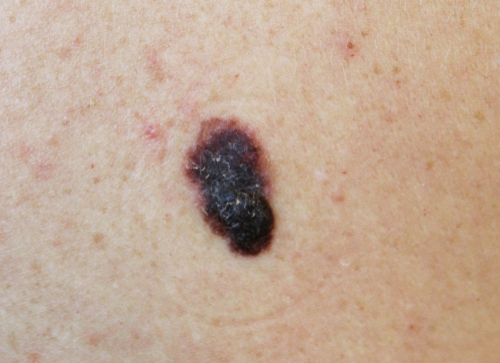Debbie Conner, PhD, MSN, ANP/FNP-BC, FAANP
Chair, School of Nursing Franklin University, Columbus, Ohio

We all know that exposure to sunshine is essential for our body to process vitamin D. However, ultraviolet (UV) radiation damages skin no matter what your skin tone. Some essential facts – 1 in 5 Americans get skin cancer, the most common type in the United States, with over five million cases yearly.(1, 2) Exposure to the sun’s UV light causes most cancers, and getting sunburned five times doubles the risk of developing melanoma, the deadliest form of skin cancer.(1) Skin that is unprotected from UV radiation (UVA and UVB) can have the DNA at the cellular level damaged as quickly as 15 minutes.(3) This damage can lead to cancer, generally divided into melanoma and non-melanoma.
The most common non-melanoma types of skin cancer are basal cell carcinoma and squamous cell carcinoma. The affected cells are in the top layer of the skin and are easily damaged from sun exposure. Skin color affects the risk of developing skin cancer. It is known that the less melanin in the skin, the greater the risk. One reason is that cutaneous melanin helps absorb UV and has antioxidant and scavenging capabilities, meaning that there is a lower incidence of skin cancer in individuals with dark skin compared to fair skin.(4) While melanoma is more common (about 30 times) in Caucasian vs. black persons, people with darker skin colors are typically diagnosed at later stages, and cancer is more difficult to treat. While more melanin may be protective, dark-skinned individuals are also at risk for melanoma or non-melanoma skin cancers. (4) This supports the importance of an annual full-body skin exam for everyone.
Full body screening with a provider or nurse is important to examine any moles, birthmarks, or other pigmented areas that look abnormal. A biopsy is needed to diagnose skin cancer definitively. While the U.S. Preventive Services Task Force has concluded there is not enough evidence to recommend for or against routine screenings(5), the National Cancer Institute 6) recommends a full body skin exam to asymptomatic adolescents and adults without a history of premalignant or malignant skin lesions. Visual exams utilize the ABCDE (asymmetry, border irregularity, nonuniform color, diameter greater than 6mm, and evolves over time) or the ugly duckling sign. This pigmented lesion does not resemble other moles on the patient’s body. A magnifying device known as a dermatoscope is used to identify lesions. Mobile phone applications have been developed to evaluate skin lesions. However, they are still new and require further research for accuracy. Providers and patients share responsibility for checking skin for new or unusual growths, especially for those at a higher risk of developing skin cancer.(7) For all, sun exposure should be done with a great deal of caution.
As with any condition, screening tests have risks, and education on prevention is a priority. The priority with prevention is to protect yourself from harmful UV radiation. Remember, the sun’s rays reflect off water, sand, concrete, snow, through fog and clouds, and even below the water’s surface. Mineral-based sunscreen such as zinc oxide reflects light away from the skin’s surface. Titanium dioxide is also recognized as a safe and effective physical sunscreen.(8) Other preventive measures include seeking shade, reapplying sunscreen every two hours, wearing lip balm with SPF 15 or higher and a hat, UV sunglasses, and other protective clothing.
References
- Infographic: UV Safety Awareness Month. Weill Cornell Medicine. July 26, 2022 https://weillcornell.org/news/infographic-uv-safety-awareness-month
- May is Skin Cancer Awareness Month. Skin Cancer Foundation. https://www.skincancer.org/get-involved/skin-cancer-awareness-month/
- Skin Cancer Awareness Month: How to Reduce your Risk. May 1, 2021 https://www.skincancer.org/get-involved/skin-cancer-awareness-month/
- LaBerge, G. S., Duvall, E., Grasmick, Z., ….Recent advances in studies of skin color and skin cancer. Yale J Biol Med 2020 March, 93(1): 69-80. PMID 32226338 https://www.ncbi.nlm.nih.gov/pmc/articles/PMC7087065/
- S. Preventive Services Task Force. Skin Cancer: Screening. April 18, 2023 https://www.uspreventiveservicestaskforce.org/uspstf/recommendation/skin-cancer-screening
- National Cancer Screening. Skin Cancer Screening (PDQ®) – Patient Version. March 30, 2023 https://www.cancer.gov/types/skin/patient/skin-screening-pdq
- Skin Cancer Foundation. Skin Cancer Prevention: Protect Yourself with a Complete Approach. 2023. https://www.skincancer.org/skin-cancer-prevention/
- What Sunscreen Ingredients to Look for –and Which Banned Ones to Avoid. Healthline. June 13, 2019. https://www.healthline.com/health/beauty-skin-care/best-sunscreen-ingredients


